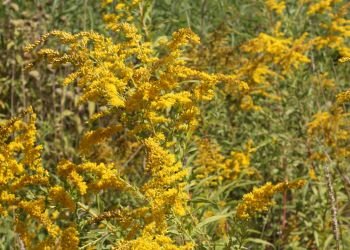Autumn Gold
Low on the western horizon, the sun’s normally harsh rays, now soft and tired, give a warm glow to the acres and acres of Goldenrod. I stand in the middle of this field, if indeed it is the middle as no matter which direction I look, a sea of gold surrounds me. The thrum of thousands of honeybees and bumblebees and other insects fill the evening sky just above the golden waves, as each flit from flower to flower gathering pollen and nectar to store in their own home treasuries. The Goldenrod is freely giving itself away.
And I think of these lines in Mary Oliver’s poem “Goldenrod,” where she initially questions the plant’s worth:
I don’t suppose anything loves it, except, perhaps
the rocky voids
filled by its dumb dazzle.
Goldenrod is not the gold humans lust for. Neither is it the Goldfinch darting low over fields ripe with seed, nor the golden colored leaves of Autumn Hickory and Aspen trees illuminating our landscapes. Nor is it the Golden Hour when just before sunset and the day’s human-made mechanical din dies down that the voices of Nature can finally be heard. No, we lust for the metal - a metal we take from the earth which has very little worth, although to which we have arbitrarily assigned a very high value.
A change overcomes Oliver. She continues:
For myself,
I was just passing by, when the wind flared
and the blossoms rustled,
and the glittering pandemonium
leaned on me.
According to the January 2023 US Geological Survey Commodity Summaries, 6% of the gold mined is used in electronics and 1% in a variety of other uses such as medicines, both providing some level of worth, making our lives better. However, the other 93% moves up the socio-economic chain to eventually be worn on fingers, dangled from ears and necks, or as bullion and coins hoarded into safes, believing that gold metal with its shiny luster has worth.
Mining for gold metal usually requires large-scale extraction where huge piles of ore are sprayed with a cyanide solution, which dissolves the gold for later precipitation and purification. Many operations use open pit practices, often destroying areas of high biodiversity and other sensitive ecosystems, leaving in their wake pollution and its associated human and environmental health costs. These practices are particularly rampant in countries that don’t have the infrastructure for adequate oversite. Local communities in the shadows of these mines take the hardest hit, trading their long-term health for short-term gain.
There must be a better way, a better compass point to follow, a new paradigm to accept, a new “gold” standard.
All day
on their airy backbones
they toss in the wind,
they bend as though it was natural and godly to bend,
they rise in a stiff sweetness,
in the pure peace of giving
one’s gold away.
The sun, having turned from golden yellow to saffron within the last hour, dips below the tree line and I feel the temperature drop a few degrees. Night is starting and I don’t want to leave yet. Actually, I don’t want to leave at all. I want to stay in this field of gold and accept the gift that is freely offered to me.
References:
Excerpts from “Goldenrod” by Mary Oliver
Data from USGS Mineral Commodity Summaries, January 2023. https://geology.com/minerals/gold/uses-of-gold.shtml
